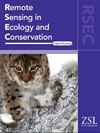Breaking down seagrass fragmentation in a marine heatwave impacted World Heritage Area
IF 4.3
2区 环境科学与生态学
Q1 ECOLOGY
引用次数: 0
Abstract
Marine heatwaves, and other extreme climatic events, are driving mass mortality of habitat‐forming species and substantial ecological change worldwide. However, habitat fragmentation is rarely considered despite its role in structuring seascapes and potential to exacerbate the negative impacts of habitat loss. Here, we quantify fragmentation of globally significant seagrass meadows within the Shark Bay World Heritage Area before and after an unprecedented marine heatwave impacting the Western Australian coastline over the austral summer of 2010/11. We use a spatial pattern index to quantify seagrass fragmentation from satellite‐derived habitat maps (2002, 2010, 2014 and 2016), assess potential predictors of fragmentation and investigate seascape dynamics defined by relationships between seagrass fragmentation and cover change. Our spatiotemporal analysis illustrates widespread fragmentation of seagrass following the marine heatwave, contributing to a dramatic alteration of seascape structure across the World Heritage Area. Fragmentation immediately following the marine heatwave coincided with widespread seagrass loss and was best explained by interactions between a heat stress metric (i.e. degree heating weeks) and depth. Based on the relationship between fragmentation and seagrass cover change, we revealed near‐ubiquitous fragmentation from 2014 to 2016 represents a mixture of long‐term seagrass degradation and evidence of early, patchy recovery. Fragmentation effects are expected to compound the ecological impacts of seagrass mortality following the marine heatwave and prolong recovery. As sea temperatures and the threat of marine heatwaves continue to rise globally, our results highlight the importance of considering fragmentation effects alongside the negative impacts of habitat loss. Our seascape dynamic framework provides a novel approach to define the response of habitat‐forming species to disturbances, including marine heatwaves, that integrates the processes of fragmentation and cover change. This framework provides the opportunity to consider these important processes across a range of threatened ecosystems and identify areas of vulnerability, stability and recovery.海洋热浪导致海草破碎,影响了世界遗产区
海洋热浪和其他极端气候事件正在导致栖息地形成物种的大规模死亡和全球范围内的重大生态变化。然而,尽管栖息地破碎化在构建海景和可能加剧栖息地丧失的负面影响方面发挥了作用,但很少考虑到栖息地破碎化。在这里,我们量化了鲨鱼湾世界遗产区内全球重要的海草草甸在2010/11年夏季前所未有的海洋热浪影响西澳大利亚海岸线之前和之后的破碎程度。我们利用空间格局指数量化了卫星生境地图(2002年、2010年、2014年和2016年)中的海草破碎化,评估了破碎化的潜在预测因子,并研究了海草破碎化与覆盖变化之间的关系所定义的海景动态。我们的时空分析表明,海洋热浪过后,海草大面积破碎,导致整个世界遗产区的海景结构发生了巨大变化。紧随海洋热浪而来的破碎与海草的大面积损失相吻合,最好的解释是热应力度量(即加热周度)和深度之间的相互作用。基于破碎化与海草覆盖变化之间的关系,我们发现2014年至2016年期间,几乎无处不在的破碎化代表了长期海草退化和早期斑块性恢复的混合。碎片化效应预计将加剧海洋热浪后海草死亡的生态影响,并延长恢复时间。随着海洋温度和海洋热浪的威胁在全球范围内持续上升,我们的研究结果强调了将碎片化效应与栖息地丧失的负面影响一并考虑的重要性。我们的海景动态框架提供了一种新的方法来定义栖息地形成物种对干扰的响应,包括海洋热浪,它整合了破碎化和覆盖变化的过程。该框架提供了在一系列受到威胁的生态系统中考虑这些重要过程的机会,并确定了脆弱、稳定和恢复的领域。
本文章由计算机程序翻译,如有差异,请以英文原文为准。
求助全文
约1分钟内获得全文
求助全文
来源期刊

Remote Sensing in Ecology and Conservation
Earth and Planetary Sciences-Computers in Earth Sciences
CiteScore
9.80
自引率
5.50%
发文量
69
审稿时长
18 weeks
期刊介绍:
emote Sensing in Ecology and Conservation provides a forum for rapid, peer-reviewed publication of novel, multidisciplinary research at the interface between remote sensing science and ecology and conservation. The journal prioritizes findings that advance the scientific basis of ecology and conservation, promoting the development of remote-sensing based methods relevant to the management of land use and biological systems at all levels, from populations and species to ecosystems and biomes. The journal defines remote sensing in its broadest sense, including data acquisition by hand-held and fixed ground-based sensors, such as camera traps and acoustic recorders, and sensors on airplanes and satellites. The intended journal’s audience includes ecologists, conservation scientists, policy makers, managers of terrestrial and aquatic systems, remote sensing scientists, and students.
Remote Sensing in Ecology and Conservation is a fully open access journal from Wiley and the Zoological Society of London. Remote sensing has enormous potential as to provide information on the state of, and pressures on, biological diversity and ecosystem services, at multiple spatial and temporal scales. This new publication provides a forum for multidisciplinary research in remote sensing science, ecological research and conservation science.
 求助内容:
求助内容: 应助结果提醒方式:
应助结果提醒方式:


